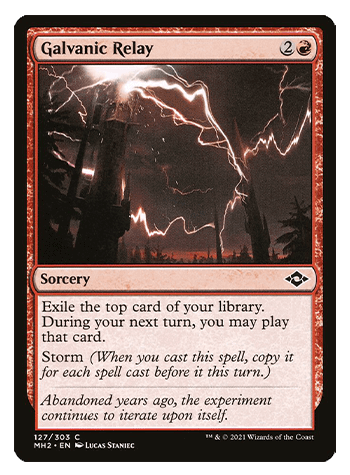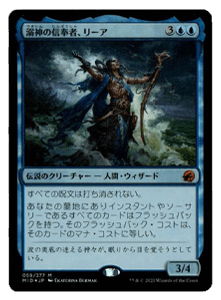Special thanks to Anuraag Das and Sam Roukas for their contributions to this article.
Miracles, with and without Sensei’s Divining Top, has been a natural predator of The Epic Storm for many years. Force of Will, Counterbalance, and Terminus combine to form a suite of cards that can be pretty difficult to beat at any stage of the game. One of the major edges that The Epic Storm players can gain is by fully understanding the Miracles player and their approach to the game in order to slip through the important pieces necessary to cobble together a win. In this article, we’re going to be hearing from two of the best Miracles players, Anuraag Das and Sam Roukas, in order to better understand the Miracles approach to the matchup. Understanding what cards they value pre-board and post-board, as well as their general view of the matchup, can hopefully allow you to make better decisions when using your own cards. Mulligans, Cabal Therapy, and baiting Counterspells are all decisions that will make or break a game, but they can be tough to make in the dark. By hearing from the Miracles point of view, you will be better poised to understand the nuances of these critical decisions.


Anuraag Das
(AnziD):
Anuraag first started playing Miracles in 2014, and has been a fervent disciple of the deck since. His finishes include a win at Eternal Extravaganza 6 and Top 8 at SCG Worcester in 2015. He sometimes streams at www.twitch.tv/anzi104, where you can find him browsing the internet for dogs and sweet Miracles tech.


Sam Roukas
(TheZooKeeper):
Sam is a mainstay of the middle of the MTGO trophy leaderboard, earning him a small amount of influence in the community. He has a positive lifetime record (2-1) against his hero Bryant Cook, with his latest and most stunning victory coming from a Force of Will buried 3 cards down, just in reach of Brainstorm. His Legacy career is highlighted by long history of registering underpowered Tundra decks to donate entry for the sake of the eventual top 8 competitors.















Cantrips also help with fighting discard. If my opening hand is redundant with cantrips, then the impact of a discard spell is reduced as I’ll be able to see lots of cards the next turn. In fact, based on the way game one usually plays out, there have been times where I’ve actually wished Force of Will isn’t in my opening hand, but rather in the sweet spot of my deck’s top 3 cards. The turn 1 Tendrils of Agony kill through Force of Will is far less likely than just a turn 1 discard spell, so if I cantrip into the Force of Will after turn 1 discard, then not only will it not have been stripped from my hand, but also my opponent won’t know for sure if I have it not (hopefully allowing me to untap). It’s a little counterintuitive and requires a bit of luck, but the potential explosiveness of this Storm variant means turns 1 and 2 have to go really well for me anyways.
Honorary mention goes to Search For Azcanta – if I’m not dead and this card flips, I’m usually able to dig deep enough and find more Counterspells.















- Counterbalance and Terminus are both excellent here. In the dark I think experienced TES pilots will try to combo as fast as possible against blue decks to avoid giving them time to filter their draws.
- Since for TES that means t1/2, Miracles’ objective is to find Force of Will/s and get a Terminus 2 cards down with a cantrip (last card down for any of Brainstorm/Ponder/Portent) t1. That way you can fetch it away t2 if they haven’t combo’d to play a Counterbalance or leave up mana for more cantrips. Miracles needs to make blue land drops before doing anything else and most of TES’ early lines involve putting Goblins into play.
- Midgame (turn ~3 or so) you want to have Counterbalance in play with cantrips up and Force of Will in hand, preferably with access to Terminus.
- The endgame usually involves floating a 1-drop for Counterbalance to protect Force of Will from discard and chipping away with Snapcaster Mage or activating Search For Azcanta end of turn to find Counterspells and a finisher.















Another “trap” I try to set up is a really medium impersonation of floating Force of Will with Sensei’s Divining Top: Brainstorm Force of Will to the top of my deck and use Snapcaster Mage or another Brainstorm to draw it in response to a post-Lion’s Eye Diamond Infernal Tutor or Burning Wish. This play has a more reasonable chance of beating discard than just holding the Counterspell in my hand but is much harder to sustain without constantly cantripping every turn.















- Resolving Counterbalance quickly is the best way to steal game 1 from storm decks, against which post-ban Miracles is unfavored.
- Floating Force of Will with sorcery-speed cantrips and a Brainstorm in hand or Snapcaster Mage in hand and Brainstorm in the yard are both also good ways to tempt storm players who Gitaxian Probe you seeing no Force of Will to go for it. If they’re cautious and you don’t have a Force, that’s more time to find one or potentially a game breaking Counterbalance.
- Like most very fast decks, TES often has to “play the odds” without full information. Knowing if you have access to Terminus or not, Force of Will or not, Counterbalance next turn or not are all information advantages you can leverage.















The scariest games versus TES are the ones where my opponent casts a discard spell on turn one and combos off on turn two. Because my game one deck is full of chaff like Swords to Plowshares, even if I cantrip it’s mathematically unlikely that I will have enough interaction to beat multiple discard spells and the combo. The problem with giving the Miracles deck time is that it just lets them dig deeper for Counterbalance, and once Counterbalance is in play it is much easier to stop the combo. Obviously in the situations where your cards tell you to grind you grind, but if you have the decision to choose between “fast and loose” or “grindy and cautious”, definitely go for the first option.















- Pre-board it depends on Miracles’ keep. Miracles has a wide range of keepable hands in the dark but only some are playable against TES. The good news is you’ll find out very quickly. The bad news is a good chunk are totally unplayable and have no way to fix it before losing.
- In any case, I think TES should be aggressive against fair blue decks because the relative quality of TES’ draws doesn’t improve over time, where Miracles’ does.
- Obviously these guidelines are dependent on a few in-game factors, but TES typically dictates the pace of the game and the pendulum will swing slowly but surely toward Miracles as it drags on.






























- It really depends on the situation. TES has access to Tendrils of Agony and Grapeshot via Burning Wish, so taking 16 from Goblins before answering them is still a problem with no clock of your own to punish them.
- Miracles is probably less concerned with Goblins than most fair decks because Terminus is an answer, but TES doesn’t give Miracles much time to find it and Sensei’s Divining Top is a big loss here.















To actually answer the question… in general in game 1 it’s probably correct to name Force of Will. The usual construction of Miracles countermagic packages is somewhere around 8 cards including 4 Force of Will and then a customized 4-card mix of Counterspell and Counterbalance. So, in the blind, it makes sense to name the card they are most likely to have. There are arguments for naming other cards based on certain board states. For example, if your opponent passes with Island + Fetch and they haven’t cast Brainstorm yet, naming Brainstorm is a reasonable option as the power level of that card is just so absurd for Miracles in the early turns. It also follows that if you have multiple discard spells you can be a little more liberal with what you name for Cabal Therapy. But yeah, usually Force in game 1 and if not, then default to the most relevantly powerful card you think they could have.
Post-board is another beast altogether. And here, I’ll stick with what I said earlier: don’t cast it till you’re going to combo. The problem is that in games 2 and 3 the Miracles deck no longer has any excess removal; do-nothing cards like Council’s Judgment and the second Plains are probably not in the deck, instead replaced by Flusterstorms, Surgical Extractions, and Red Blasts. With so many additional risks, blindly firing off Cabal Therapy seems loose when there are so many other methods of interacting. Additional justification for sandbagging Cabal Therapy is that Post-board the Storm player has access to Abrupt Decay so the Counterbalance endgame isn’t as invincible. Subsequently, this means the option to grind is available and you’re not forced as the combo player to unload your spells immediately. Yet another point for holding the Cabal Therapy is that the Miracles deck rarely has pressure. If they aren’t killing you, you have time to sculpt your hand to find that Duress or Gitaxian Probe.
This isn’t to say that you should always wait till the perfect Cabal Therapy. There are lots of situations where it is correct to cast Cabal Therapy blind. If you are tight on mana, for example on turns 1 and 2, it may be correct to cast Cabal Therapy if the probability of winning seems high enough to balance the risk of missing and being down a card. Another situation is if the Miracles player actually does have pressure, either through Mentor, Clique, or multiple Snapcaster Mage. The intuitive logic for casting Cabal Therapy here is that if you don’t you potentially die and that is the lowest EV play.
So what do you name then if you face these conditions? In addition to Force of Will and Brainstorm, I really like naming Flusterstorm. The same logic applies for naming this card – the power level of this card is just absurd as it is a functional one mana hard counter to the combo. There’s a slight tradeoff in choosing between Force of Will and Flusterstorm and that should be a function of what your hand is strong and weak against. If you have access to Past in Flames or natural Tendrils of Agony it is more reasonable to name Flusterstorm, but if you suspect a Snapcaster Mage or your opponent is tight on mana, naming Force of Will is great.















- It depends (of course) what constitutes a typical scenario. The best candidates are cards Miracles is looking for to justify a keep or likely to have in their hand at a given point in time.
- What I mean by this is (for example) Counterbalance would be a good name t1 or 2 assuming TES can’t combo before it comes down, but on turn 7 if they have 5 lands in play and didn’t cast it their previous turn, it’s probably not in their hand.
- Force of Will is usually the best name when intending to jam an early Ad Nauseam game 1, but Flusterstorm is a better name if you have Empty the Warrens in hand and can afford a ritual getting Forced Post-board.
- Short answer, it depends.






























- Against TES I usually leave all 4 copies of Terminus in because Empty the Warrens is their easiest kill. Burning Wish also makes Empty the Warrens a viable option for hands that can’t Ad Nauseam or if the Miracles player needs to let a Wish resolve at the beginning of their combo turn.
- If I have Engineered Explosives or Izzet Staticaster in my 75, I might consider boarding out a Terminus but Miracles has enough deadweight game 1 that it usually doesn’t make sense to board out wraths.
- One more note here is the best sideboard strategy is a mixed approach. I often change the number of Red Blasts, Surgical Extractions, Monastery Mentors, or other sideboard cards that aren’t obvious home runs between games. Forcing the combo player to keep guessing how you approach the matchup will prevent them from taking risks that could pay off in a big way if they correctly identify you for a player who always does X. Insulating yourself against free wins and picking up your own is critical over a long tournament.






























- I don’t keep dedicated answers to Xantid Swarm post-board and won’t bring any in for game 3 barring some extraordinary circumstance, like seeing 4 copies from a Surgical Extraction.
- I think it makes more sense to plan for the most likely situations and ensure you win them. That means games where TES doesn’t have Xantid Swarm but does have mana and tutors. Plan accordingly.
- That said, much of the power of transformational plans is they demand different answers than typical incoming sideboard cards, often the cards they’re replacing. My opinion is Miracles can afford not to have a card like Swords to Plowshares post-board if leaving in Terminus for Empty the Warrens anyway. Miracles gets to cheat a little here, since Terminus is better than say, Lightning Bolt. But many Bolt decks have Kolaghan’s Command, which will knock out a Xantid Swarm before it can trigger unless the TES player has it in their opening hand. Again, prepare for the most likely situation (they don’t have it to begin, but could eventually draw it) rather than the corner case that feels bad in the moment.















+3 Surgical Extraction, +2 Engineered Explosives, +3 Flusterstorm, +1 Pyroblast
-2 Swords to Plowshares, -2 Terminus, -1 Council’s Judgment, -1 Entreat the Angels, -1 Jace, the Mind Sculptor, -1 Back to Basics, -1 Plains















- My favorite sideboard cards against combo are hate pieces that attack from a different angle than my main deck. For Miracles that means permanents and flash threats like Ethersworn Canonist, Rest in Peace, and Vendilion Clique. Attacking from an unexpected angle can buy a ton of time for the rest of your deck and some, like Ethersworn Canonist, prevent the combo player from winning altogether until they’re removed.
- Siding cards out with Miracles is mostly straightforward: take out the half that’s awful for cards that aren’t. Against TES from the above list, I’m looking at 4 Swords to Plowshares, 2 Plains, 1 Entreat the Angels, and 1 Council’s Judgment. Those 8 slots would become 3 Flusterstorm, 3 Surgical Extraction, 1 Snapcaster Mage, and 1 of either Monastery Mentor or Pyroblast.
- For game 3 I might switch out my 3rd Jace, the Mind Sculptor or Surgical Extraction for another Monastery Mentor or Pyroblast, or board back in 1 Plains if I’m on the play. Alternatively if we’re low on time or my opponent is timid, I’ll board in all of my Monastery Mentor or Pyroblast and take out Jace, the Mind Sculptor to put pressure on them early.






























- Pre-board games tend to revolve around how many blue cards the Miracles player draws. TES is more easily disrupted than most combo decks because it needs to assemble mana in two colors. The fundamentals apply here – find Force of Will early and Counterbalance as soon as you can. I much rather play game 1 loose since I’m already at a disadvantage from having 10 white cards in my deck, but the value of stealing game 1 is it makes Post-board games much easier.
- Post-board games swing the other way, since Miracles trades all its chaff for hate and TES boards in clunk for its second-tier enablers. I approach game 2 (typically on the play) as an opportunity to slam a quick Counterbalance and aggressively pressure TES’ life total to hobble them before they can resolve Ad Nauseam.
- On the draw, I’ll play more cautiously unless I have a potentially aggressive hand. An example of this would be lands, cantrips, Snapcaster Mage and Force of Will. This hand is casting multiple spells in the first couple turns and can flash in a Snapcaster Mage to start a clock without feeling too far behind from being on the draw.
- Overall I think Miracles’ 60 improves post-board, while TES’ declines. All combo decks only want as much interaction as they need while keeping their engine running, but Miracles is grateful to trade dead cards for live ones. Since both decks board in interaction, post-board games slow down to Miracles’ benefit.






























- I think the best option is trying to resolve Ad Nauseam quickly. Granted that’s not always possible in Post-board games, where Miracles is more likely to have multiple early interactive spells and TES takes on deadweight in the form of Abrupt Decay or other cards that aren’t mana, tutors, or filtering.
- That said, long games inevitably favor Miracles as it establishes mana to cast spells and picks up interaction. Neither of those is a good situation for TES.
- Ideally, the TES player will cantrip for action with an eye toward executing the combo as soon as there’s an opening. It’s also possible to disguise which resource is their choke point, potentially leading the Miracles player to counter the wrong thing and let TES combo freely.

















Real answer: Yes. Search For Azcanta gives me an endgame that is harder to interact with than Counterbalance. When flipped, the Sunken Ruin is basically impervious and will keep fueling me with gas. Other than that, I’ve noticed Search For Azcanta has been replacing the Snapcaster Mage and Predict slots, so while it adds a great long-term plan, the mid-game lacks the “draw-go” aspect. I’m still trying to figure out how to fit everything, but with this many Search For Azcantas I have to cut something. My tradeoff is adding more cheap Counterspells, specifically the fourth Flusterstorm. This way I can more aggressively tap out for Search For Azcanta on turns 4 and 5 while also holding up multiple Counterspells.















- Search For Azcanta is a huge deal for Miracles across the board because it reduces the number of games where Miracles runs out of gas after answering early threats. That said, I don’t think it plays a huge role against TES because of the speed of the matchup.
- Abrupt Decay should be coming in anyway for Counterbalance and hate permanents, but Search For Azcanta is pretty low on the list of immediately dangerous cards compared to Counterbalance and Ethersworn Canonist.
- Given the choice between Decaying a Search For Azcanta that’s about to flip and risking not being able to remove a future Counterbalance versus holding the Abrupt Decay knowing Search For Azcanta will draw some cards, I think that’s a judgment call the TES player needs to make based on how much work their hand needs to start the combo.






























- As a reactive deck, Miracles needs to respond to trends in the metagame. Ethersworn Canonist was a necessary sideboard choice for the expected prevalence of storm decks immediately post-ban. “Summer Miracles” didn’t even have Counterbalance, so more specific hate was needed. Between the re-adoption of Counterbalance and the new introduction of Search For Azcanta, current Miracles main decks are about 5 cards off pre-ban versions. While they’re still ill-equipped to beat storm decks regularly, Counterbalance adds desperately needed percentage points to Miracles’ side.
- Another factor in the disappearance of Ethersworn Canonist is the reduced popularity of storm overall in paper magic. Practical issues aside (card availability, opportunities to play Legacy tournaments), both storm variants have a tough time with Deathrite Shaman decks, which are popular right now. For the moment, I think Ethersworn Canonist will stay on the sidelines (not in the sideboard), but could see that change if Deathrite Shaman decks over-meta for one another and storm makes a serious comeback.















Regarding other combo decks, I don’t think I’m as fearful of TES as I am of Show & Tell or Dredge, even though I would not be excited to play TES multiple times in an event. The latter combo decks have access to cards or mechanics that are difficult to interact with; SNT features nonsense like Boseiju, and Dredge renders Counterbalance useless with a bajillion triggered abilities. Miracles is very good at fighting on the stack, which is part of the reason why it can put up some serious game against Storm.















- I think it’s a mistake to compare TES and ANT. They both abuse storm cards for lethal combos, but TES is a stack-based Ad Nauseam deck, while ANT is a graveyard-based Past in Flames deck. They’re both fast and depend on critical cards resolving, but in practice many of the most effective hate cards are different.
- That said, I think TES is the easier deck for Miracles for 3 reasons: A.) More of TES’ lines rely on Empty the Warrens, for which Terminus is a main deck 4-of answer. B.) Ad Nauseam is a fairly high bar to clear for 2 colors of rituals, even if Ad Nauseam from 0 mana floating is likelier to be lethal. C.) ANT typically benefits from waiting, TES rarely does.
- In practice, TES’ wins more often come from doing something unexpected, while ANT wins by overpowering Miracles with a blue-killing control game.
- Combo decks are generally a challenge for Miracles, both pre and post-ban. The 3 most common combo decks as of this writing (BR Reanimator, Sneak Attack, ANT) are all favored against the average Miracles build in a best of 3 match. For example, looking at Francis’ sideboard he could reasonably side in up to 14 cards against Sneak Attack – that’s not a sign of a good matchup.
- TES’ biggest strength compared to other combo decks is the flexibility of access to both Empty the Warrens and Tendrils of Agony kills. Forcing Miracles to draw Terminus in what’s fundamentally a stack-based matchup is a huge advantage compared to Sneak Attack where blue cards are always good and white cards are always bad.















It’s much harder for me to say the other way around, but if I had to guess, it’d be identifying the crucial spells at any given point in the game. More specifically, I think ritual spells are countered far less than they should be. In situations where my hand is just ridiculously full of countermagic, the ways I can still lose are when my Storm opponent uses oodles of excess mana to get around Flusterstorm or cast Past in Flames twice in a turn. Especially if I have pressure or have seen my opponent stock up on discard spells via Infernal Tutor, I like to attack the ritual effects since it stops the Storm deck from going all-out in one turn. One of the dead giveaways that I need to shift gears is when my opponent casts Gitaxian Probe, sees 2 or 3 Counterspells, and then casts Dark Ritual. At that point, I need to ask myself what cards they could have that merit such a play and adjust accordingly. It’s not an easy skill to master, and the only reason I even know this is underrated is because I’ve died many, many times when I thought I had the game wrapped up.















- I think Storm players make a few mistakes consistently against Miracles. The most common I see is using all of their discard early, but not saving any for the combo turn to strip a freshly drawn Counterspell or go off with perfect information. For a storm player this is inexcusable because it’s fundamental to playing combo with discard.
- The other common mistake I see is discarding cards that are good in the matchup, but not relevant to the current game-state or the TES player’s hand. My favorite example is taking Brainstorm from an otherwise great Miracles hand. There’s some benefit to removing the choice Brainstorm affords, but if Miracles already has all the interaction they need, what else were they going to find with that Brainstorm anyway?
- Conversely, the most common mistake I see from Miracles players is not understanding the danger of tapping out at various points in the game. Sometimes Miracles needs to take calculated risks, but knowing when it’s acceptable is a skill that comes with practice.
For more great content on the Miralces match-up versus TES matchup:
01-17-2018 Matchup Mulligan: Miracles by Bryant Cook on theepicstorm.com
07-04-2017 Fighting Miracles in the Post-Top Era by AJ Kerrigan on theepicstorm.com
08-04-2016 Fighting the Miracles Menace by AJ Kerrigan on theepicstorm.com





